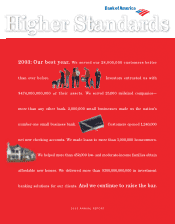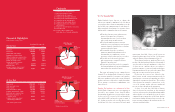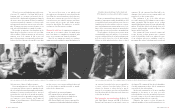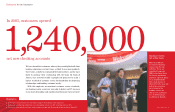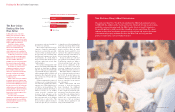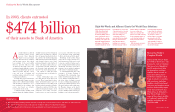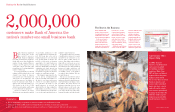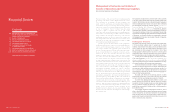Bank of America 2003 Annual Report Download - page 4
Download and view the complete annual report
Please find page 4 of the 2003 Bank of America annual report below. You can navigate through the pages in the report by either clicking on the pages listed below, or by using the keyword search tool below to find specific information within the annual report.
customers, shareholders and communities. Customers will
benefit from the broadest retail franchise in the nation, a
shared commitment to service excellence, and a full range
of traditional and innovative financial products and services.
Shareholders will benefit from our presence in the best
growth and wealth markets in America and unmatched
diversity of revenues and resources. Our communities will
benefit from our shared tradition of public-private part-
nership, community development banking and philan-
thropic investment in the communities we serve.
Your company’s expansion into the Northeast marks an
exciting new era in our history and the creation of what we
believe will be the country’s premier financial institution.
A tradition of leadership. I have said that after we
merge with our new partners at Fleet, we will continue to
be a leader, not only for our customers and shareholders,
but for our communities as well. This commitment follows
a long tradition at Bank of America of running our compa-
ny with a clear understanding of the vital link between the
health of our businesses and the health of the communi-
ties in which we operate.
Five years ago, we announced a 10-year, $350 billion
commitment to community development lending and
investing, at that time unprecedented in history. Since
then, we have loaned and invested more than $230 billion
in traditionally underserved American communities, put-
ting us on pace to exceed our goal well ahead of schedule.
This performance is why we recently decided to set a
new, even more ambitious target: Bank of America will
raise its community development lending and investing
goal to $750 billion over 10 years starting in 2005, once
again setting a higher standard for community develop-
ment banking in our country. In addition, we will set a
10-year goal for philanthropic investment—something we
believe no other U.S. company has ever done—of $1.5 bil-
lion, an average annual increase of 40% over the combined
2004 philanthropy budgets of Bank of America and Fleet.
Our escalating commitment to our communities is a
demonstration of what we mean when we talk about the
important idea upon which Bank of America is founded:
that people are at their best when they are striving to
exceed the accomplishments of the past. It’s this spirit of
constant striving that has driven our country forward
since its founding and continues to drive our company for-
ward in our pursuit of higher standards of performance for
our customers, our shareholders and our communities.
In closing, I would like to thank our Board of Directors
for their guidance and leadership during a year of great
challenge and great achievement. To those who are
departing the board as a result of the merger, I offer my
sincere gratitude for all your contributions to our suc-
cesses, past and present. To those who will continue with
us, I look forward to all we’ll achieve working together in
our new company.
Finally, I would like to thank our customers, who grant
us the opportunity every day to serve their financial
needs; our associates, who work hard every day to build
the company we all envision; and our shareholders, whose
investment in this company makes our success possible.
It is for all of you that we strive every day to set—and
exceed—a higher standard.
As always, I welcome your thoughts and suggestions.
Bank of America in 2003 passed a milepost only a handful
of companies in the world have reached, earning more
than $10 billion in a year.
Earnings of $10.8 billion were up 17%
from 2002. Earnings per share (diluted) of
$7.13 represented a 21% increase over 2002.
All the company’s major business lines
recorded double-digit increases in earnings.
Revenue on a fully taxable-equivalent
basis grew 10%, as the company’s initia-
tives to improve the customer experience
brought in more business. The company took advantage of
the low-interest-rate environment to originate a record
$131 billion in first mortgages, a 49% increase from 2002.
We had double-digit growth in card and mortgage banking
income and significant improvement in investment bank-
ing income.
Non-interest expense rose 9%, driven by higher benefit
costs, revenue-related incentive compensation and other
factors. The efficiency ratio improved to 52%.
Net securities gains increased to $941 million from
$630 million, as the company repositioned its assets and
liabilities in response to interest rate movements.
Credit quality improved significantly, resulting in a 23%
decline in the provision for loan losses. Net charge-offs
were down 16%. Commercial and large corporate net
losses fell. The consumer portfolio continued its steady
performance. Nonperforming assets at year end were
down 43% from 12 months earlier.
Profitability continued to improve. Return on equity
rose to 22%, from 19% a year earlier. Shareholder value
added, which measures our level of profit above the cost of
capital, grew 49% to $5.62 billion.
The company’s strong performance was again led by
Consumer and Commercial Banking (CCB), which
accounted for about 70% of earnings. CCB earnings rose
15% to $7.52 billion, as revenue grew 11% driven by record
mortgage originations, strong growth in credit and debit
cards and a 10% increase in average deposits.
Global Corporate and Investment Banking earnings
reached $2 billion for the first time, up 29% from 2002, as
market-based and investment banking activity increased
and provision expense declined 61%, reflecting significantly
lower loan charge-offs.
Asset Management earnings rose 79% to $670 million,
due to lower provision expense, one large equity gain and
improved equity markets.
Equity Investments reported a net loss of $249 million,
an improvement from a $331 million net loss the previous
year. Impairments during 2003 continued to outpace cash
gains and mark-to-market adjustments.
The company continues to leverage the advantages of
scale, high profitability and significant cash flow for the
advantage of shareholders.
During the year, the company returned approximately
$10 billion to shareholders through dividends and net
share repurchases. Total shareholders’ equity finished the
year at $48.0 billion. Year-end assets were $736 billion. The
Tier 1 Capital ratio at year end was 7.85%, a decline of 37
basis points, reflecting higher risk-weighted assets. Senior
management is comfortable with a lower Tier 1 ratio, given
the improved economy.
These results compare quite favorably with those of
our peers. Our goal remains to produce consistent, solid
annual earnings increases while managing our capital
wisely in order to produce an attractive total return
for shareholders.
4BANK OF AMERICA 2 0 0 3 BANK OF AMERICA 2 0 0 3 5
KENNETH D. LEWIS
Chairman, Chief Executive Officer and President
March 15, 2004
Net Income
($ in billio ns )
2001 2002 2003
Earnings Per Common Share
(dilute d)
2001 2002 2003
$ 7 .1 3
$ 5 .9 1
$ 4 .1 8
$ 1 0 .8
$ 9 .2
$ 6 .8
Return on Average Common
Shareholders’ Equity
2001 2002 2003
1 4 .0 %
1 9 .4 %
2 2 .0 %
Revenue
(fully taxable-e quivalent bas is)
($ in billio ns )
2001 2002 2003
$10,810,000,000
In 2003, Bank of America earned a record
$ 3 8 .5
$ 3 5 .1
$ 3 5 .0
JAMES H. HANCE, JR.
Vice Chairman and Chief Financial Officer
FPO-Sandy to Replace

